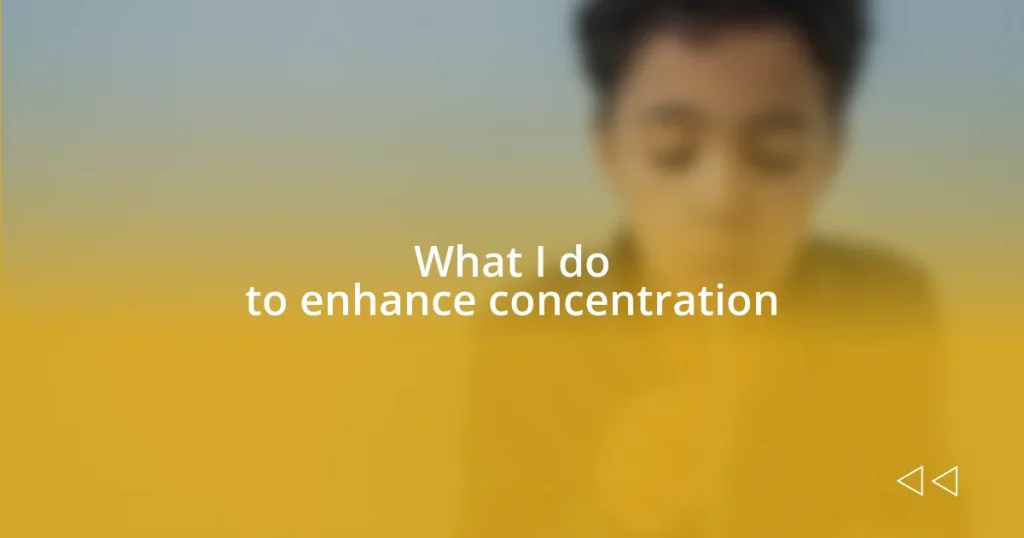Key takeaways:
- Creating a conducive environment with minimal distractions, proper lighting, and organization enhances concentration.
- Implementing time management techniques like the Pomodoro Technique and task prioritization helps maintain focus and productivity.
- Incorporating mindfulness practices and a balanced diet significantly improves mental clarity and concentration levels.
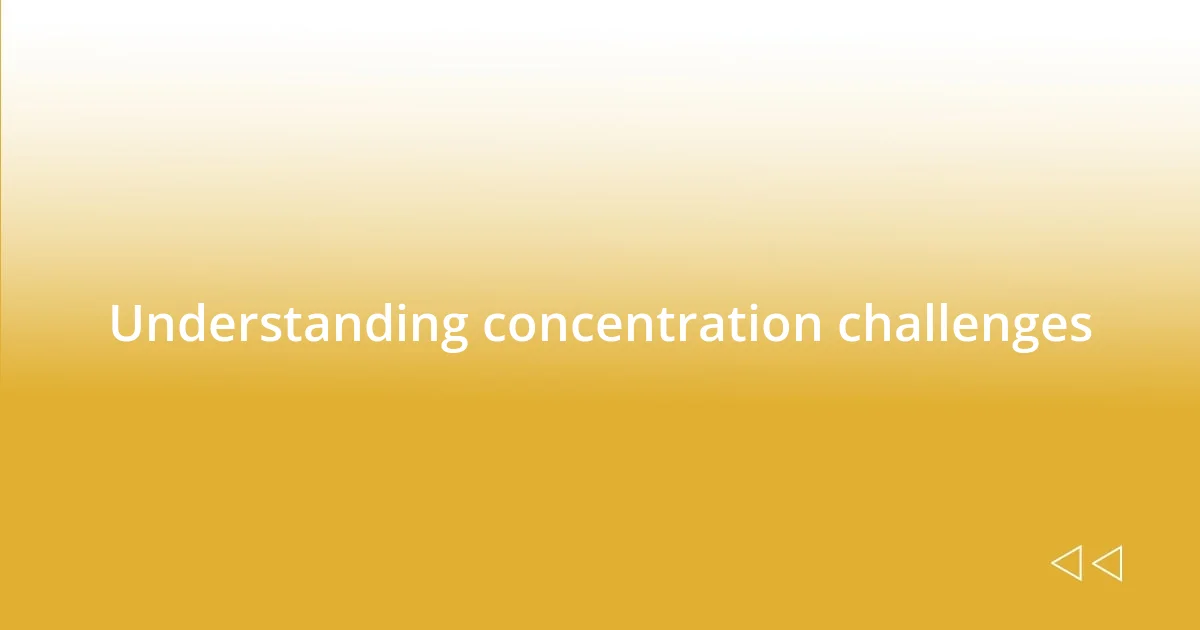
Understanding concentration challenges
Concentration challenges can stem from various sources, such as stress, distractions, or even lack of sleep. I remember a time when I was juggling too many responsibilities, and it felt like my brain was in constant overdrive. Have you ever felt that overwhelming sense that no matter how hard you try, you just can’t focus? It’s exhausting.
I’ve often found that our environments play a crucial role in how well we can concentrate. For instance, I thrive in quiet spaces but have struggled to focus in bustling cafes. The noise, while thrilling to some, becomes a distracting symphony that pulls my attention away. Have you noticed how certain settings can either ignite or stifle your focus?
Another key challenge is our relationship with technology. I can’t count how many times I’ve picked up my phone for “just a minute” only to lose track of time in a social media rabbit hole. Does this resonate with you? It’s crucial to examine how our habits around technology contribute to our concentration difficulties. Recognizing these patterns can be the first step towards reclaiming our focus.
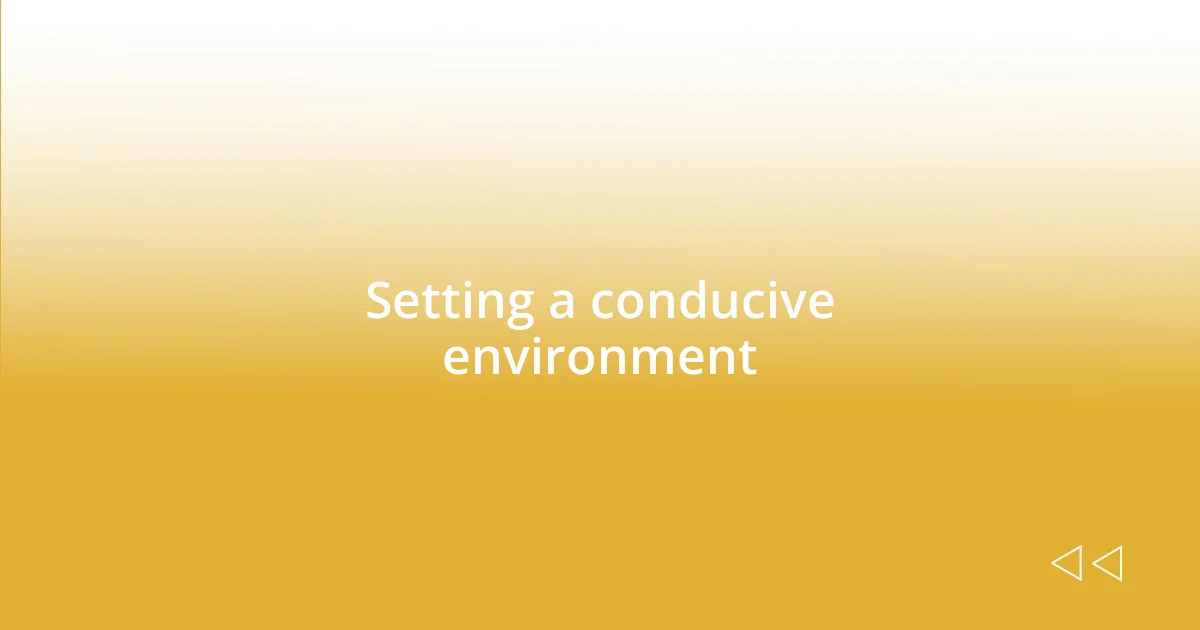
Setting a conducive environment
Creating an environment that fosters concentration is vital for me. I’ve found that a clutter-free workspace significantly improves my focus. When I sit at a desk littered with papers and trinkets, my mind becomes just as chaotic. I remember one occasion when I spent an hour tidying up my desk, and afterward, I was amazed at how much easier it was to block out distractions and dive into my work.
Here are some elements that I consider essential for a conducive environment:
- Quietude: I seek out spaces with minimal noise—sometimes I even use noise-canceling headphones to create my own bubble.
- Lighting: Natural light invigorates me, so I position my desk near a window whenever possible.
- Comfort: A supportive chair makes all the difference. I can easily lose track of time when I’m comfortable.
- Personal Touches: A few inspiring photos or a plant can brighten the space and make it feel more inviting.
- Organization: Keeping my tools and resources within reach helps me stay focused and prevents unnecessary interruptions.
Reflecting on these elements, I’ve realized that even the smallest adjustments can lead to a more productive atmosphere. Just last week, I moved my desk facing a wall adorned with my favorite artwork, and the change instantly enhanced my creativity and concentration.
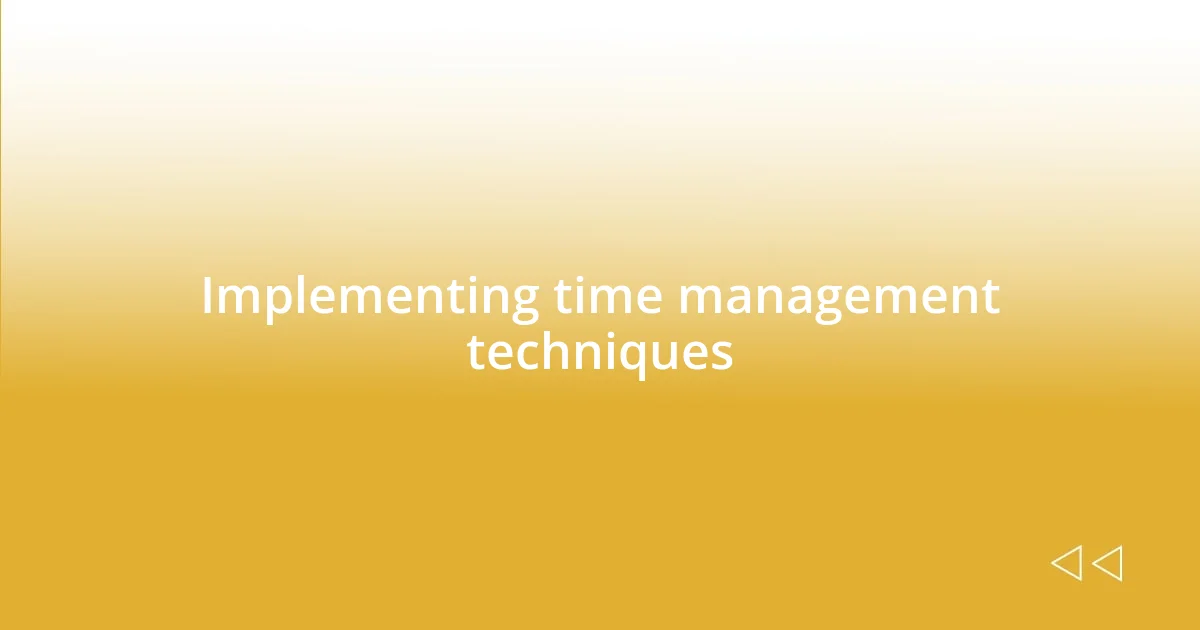
Implementing time management techniques
Implementing time management techniques can drastically boost concentration. I remember grappling with endless to-do lists, feeling overwhelmed by the sheer volume of tasks. Once I discovered the Pomodoro Technique, where you work for 25 minutes and then take a five-minute break, I found a rhythm that really clicked. Those brief respites became moments of rejuvenation, allowing me to return to tasks with greater clarity and energy.
Setting priorities is another crucial aspect. I often start my day by identifying three top tasks that must be accomplished, which helps me to navigate through potential distractions. This practice not only gives my day structure but also creates a sense of accomplishment as I tick off completed tasks. Have you ever experienced the satisfaction of crossing an item off your list? It’s such a morale booster!
Lastly, I’ve learned the value of setting boundaries around my time. For instance, I designate specific hours for deep work, during which I refrain from checking email or social media. Implementing this technique has allowed me to hone in on what truly matters without getting sidetracked by notifications. The feeling of being in the zone and making significant progress is incredibly rewarding.
| Technique | Description |
|---|---|
| Pomodoro Technique | Work for 25 minutes, then take a 5-minute break to recharge. |
| Task Prioritization | Identify three essential tasks to focus on each day, enhancing clarity and purpose. |
| Time Boundaries | Set specific hours for uninterrupted work to minimize distractions. |
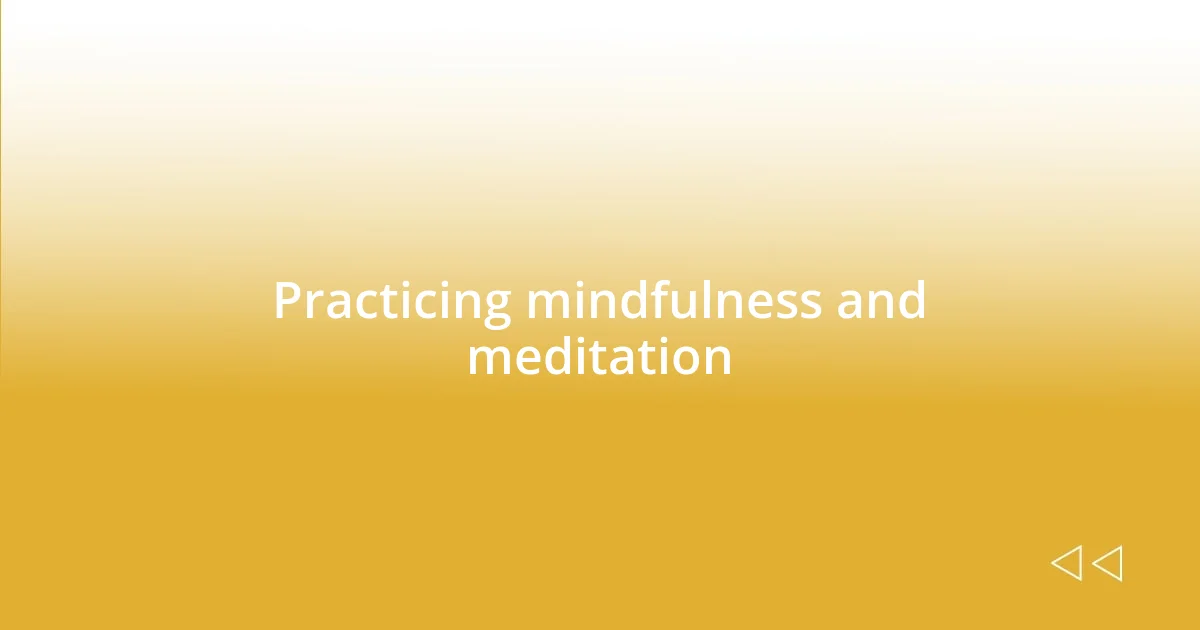
Practicing mindfulness and meditation
Practicing mindfulness and meditation has profoundly changed how I approach my daily tasks. I’ve found that dedicating just ten minutes each morning to mindfulness meditation helps me cultivate a sense of calm and focus for the rest of the day. When I close my eyes and concentrate on my breath, I can feel the swirling thoughts quieting down. It’s like hitting a reset button for my mind—have you ever experienced that feeling of clarity after a few moments of stillness?
One time, I was feeling incredibly overwhelmed by an upcoming deadline. Instead of diving right into work, I chose to meditate for a short session. As I focused on my breath, I noticed my worries began to shrink, and a wave of clarity washed over me. Returning to my tasks afterward, I was surprised at how much more efficiently I could concentrate. It seems counterintuitive, but those moments of mindfulness really do recharge the brain, don’t you think?
Incorporating mindfulness into my daily routine has also heightened my awareness of distractions. I’ve learned to observe my thoughts without judgment, which allows me to regain focus much more quickly when my mind wanders. For example, during a particularly intense work session last week, a distracting thought crossed my mind. Instead of spiraling down that rabbit hole, I simply acknowledged it, returned to my breath for a moment, and was able to create a clear path back to my work. This practice has turned distractions into opportunities for growth—it’s empowering!
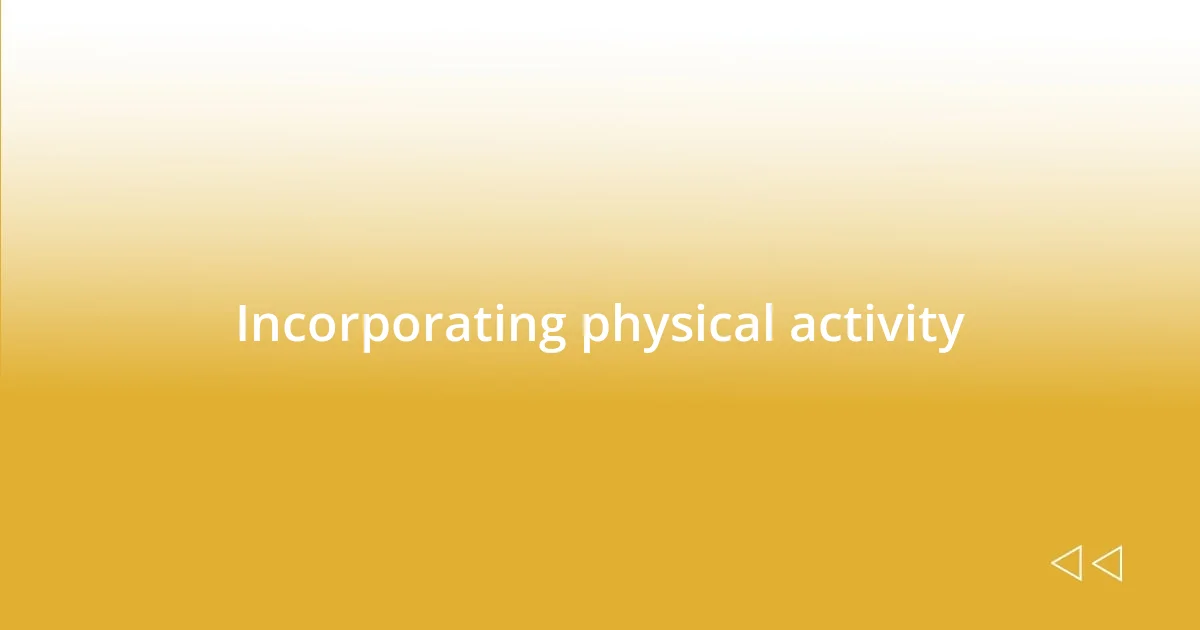
Incorporating physical activity
Incorporating physical activity into my daily routine has been a game changer for my concentration. Whether it’s a brisk walk during lunch or a quick set of jumping jacks between tasks, I’ve noticed that even short bursts of movement can refresh my mind. Have you ever stepped outside for a breath of fresh air and returned feeling invigorated? That’s the magic of physical activity; it breaks the monotony and re-energizes our focus.
I remember a particularly grueling study session where I hit a mental block after hours of being sedentary. Instead of pounding my head against the desk, I decided to go for a run. Something about the rhythm of my feet hitting the pavement, coupled with the rush of endorphins, helped clear my mind. When I returned, I was ready to tackle the material with a newfound enthusiasm. It’s such a simple shift, yet it can dramatically alter the way you engage with your work, don’t you think?
Additionally, I’ve found that integrating stretches or yoga poses into my day acts as a reset button for my brain. When I feel tension building up, taking just a few moments to stretch not only relieves physical tightness but also heightens my awareness. I often ask myself, “How can I transform this moment of stress into energy?” Empowering myself through movement provides clarity and focus—it’s a reminder that our minds and bodies must work in harmony.
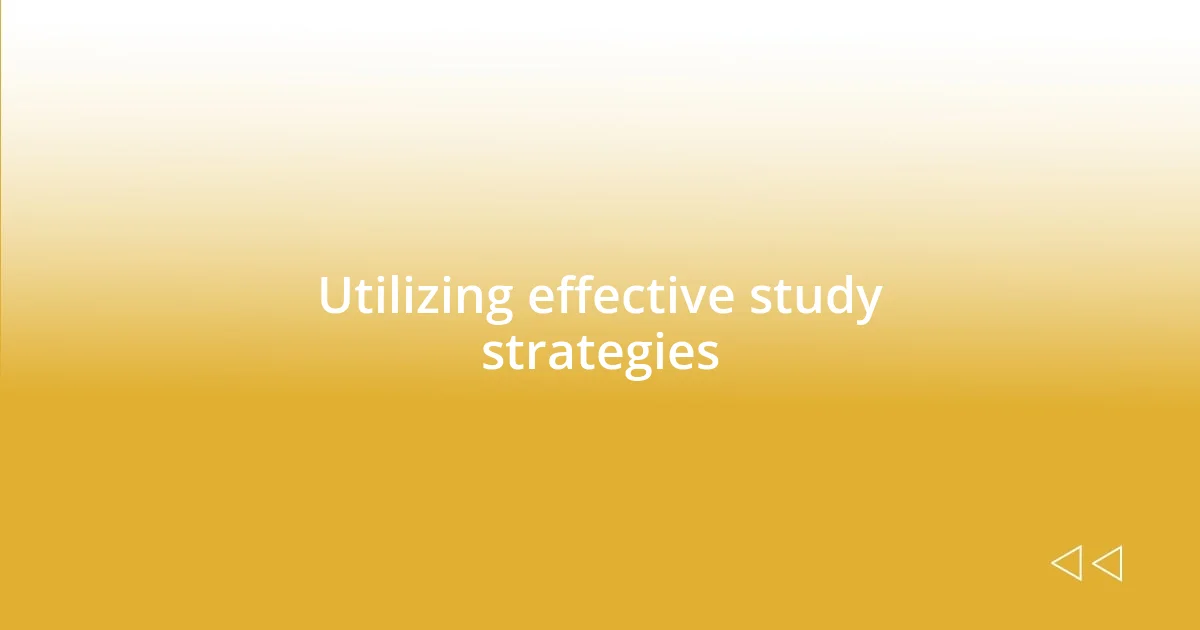
Utilizing effective study strategies
Utilizing effective study strategies truly lies at the heart of enhancing concentration. One technique that has consistently worked for me involves breaking my study sessions into manageable chunks. I typically use the Pomodoro Technique, which means I study for 25 minutes and then take a 5-minute break. This rhythm not only keeps me focused, but it also adds an element of urgency—like a mini race against the clock. Have you tried setting a timer and noticing how it changes your focus?
There was a particularly dense reading assignment that left me feeling overwhelmed. Instead of attempting to digest it all in one sitting, I broke it down into sections, setting specific goals for each session. It felt almost playful—like piecing together a puzzle. By giving myself those small wins, I could celebrate milestones along the way, which not only boosted my morale but made each piece of information more digestible. After that experience, I’ve made chunking a staple in my study strategy—it brings a sense of accomplishment, don’t you agree?
Another method that I find invaluable is using visual aids like diagrams or mind maps. I vividly remember studying for an exam where I transformed the entire syllabus into a colorful mind map. Mapping out the relationships between concepts allowed the information to stick more effectively. Visualizing the material felt like constructing a web of knowledge, where every string connected to another. This didn’t just help me remember; it made the learning process a lot more engaging, turning potentially dry content into a vivid narrative. Have you ever considered how visuals could enhance your understanding? It’s amazing what a little creativity can do for concentration!
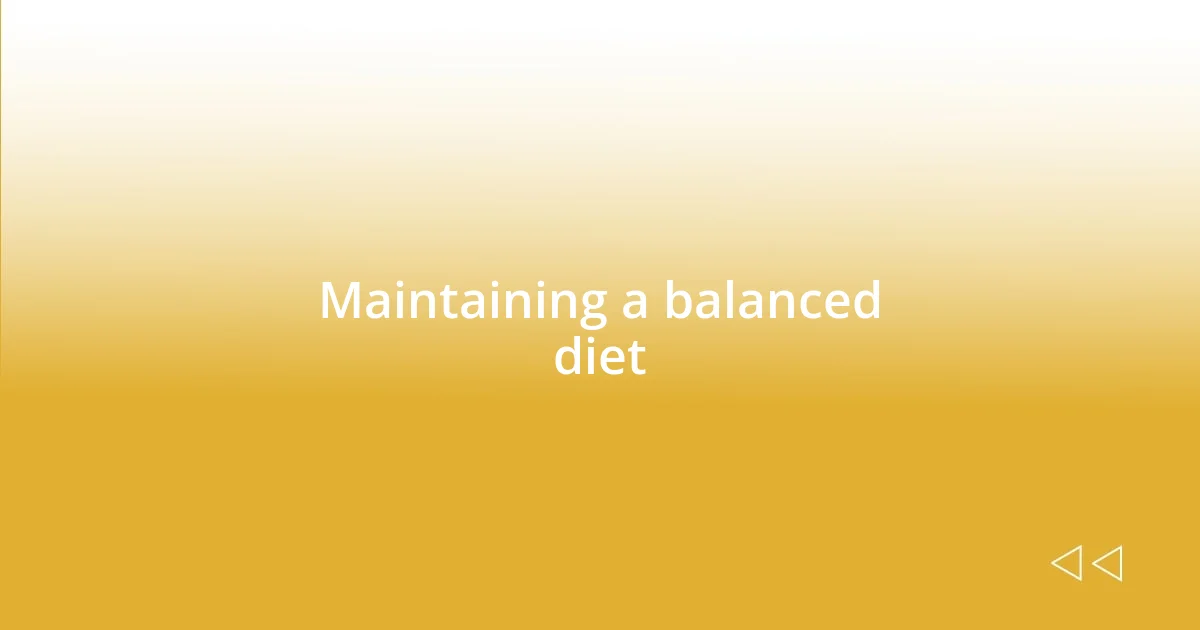
Maintaining a balanced diet
Maintaining a balanced diet has been pivotal for my concentration levels, and I can’t stress its importance enough. I’ve noticed that when I skip meals or indulge in junk food, my focus tends to wane. Ever had that foggy brain feeling after a heavy lunch? It’s like trying to drive through a thick mist; everything feels sluggish. By prioritizing a diet rich in whole foods—like fruits, vegetables, and lean proteins—I feel both energized and clear-headed, ready to tackle whatever task is at hand.
I remember a time when I was preparing for an important presentation. In the weeks leading up, I consciously avoided processed foods and made a habit of meal prepping. Being mindful of my food choices not only kept my energy levels stable but also helped me feel more in control amidst the stress. I often reflect on how much better my mind performed when fueled with nutrients rather than empty calories. It’s a choice—I could either feel sluggish or vibrant, and I chose the latter.
One trick that I’ve incorporated is starting my day with a protein-rich breakfast. I’ll whip up some eggs with spinach and a side of fruit, and let me tell you, it makes all the difference. Instead of feeling like I’m dragging myself through the morning, I feel alert and motivated. It begs the question: why would I settle for anything less when I know how impactful a well-balanced meal can be? Having a nutritious breakfast is like giving my brain a gentle wake-up call, preparing it for the challenges that lie ahead.










